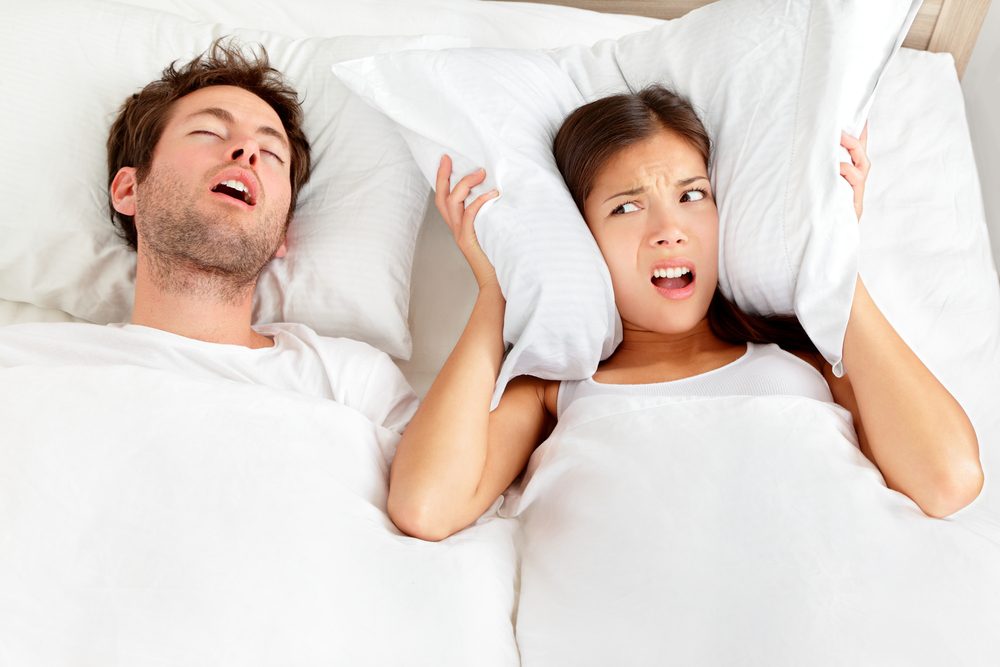Medical Disclaimer: The following content should not be used as medical advice or as a recommendation for any specific supplement or medication. It is important to consult your health care provider prior to starting a new medication or altering your current dosage.
Many people snore on occasion, whether they know it or not. Research shows that among adults aged 30 to 60, about 44% of men and 28% of women snore on a regular basis. Although snoring alone is not considered a serious health problem, it may be a sign of an underlying sleep disorder, like sleep apnea.
Regardless of whether you are aware of your snoring, it can be helpful to learn about what causes snoring, how to treat it, and when to speak with your doctor.
Why Do We Snore?
Snoring is the sound that air makes when it passes across the relaxed or loose tissues of the upper airway. During sleep, the muscles in the back of the mouth, nose, or throat become relaxed and breath flowing through the airway causes them to vibrate or flap. This action produces the rumbling, whistling, or choking sounds associated with snoring.
Risk Factors for Snoring
Anything that obstructs or narrows a person’s airway increases the chances of snoring. For example, congestion from a sinus infection or allergies can block airflow through the nose or throat, so it’s not uncommon for people with chronic congestion to snore.
Extra tissue surrounding the neck and airway from weight gain may increase the risk of snoring. Snoring also increases as people reach the end of pregnancy.
Some people are also more likely to snore at some point during their lifetime, including those who are postmenopausal, men or anyone assigned male at birth, and older adults.
In addition, certain anatomical features can also increase the likelihood that a person will snore, such as:
- Nasal polyps or growths inside the nasal passages
- A deviated nasal septum, which occurs when the wall between the nostrils is bent or crooked
- Swollen tonsils or adenoids, which is especially common in children
- A small mouth with a large tongue
- A tongue that has a base larger than the rest of the tongue
Symptoms of Snoring
When a person snores, they emit a snorting, raspy noise that can be heard by others. Some people snore softly, but others may snore so loudly that people in another room can hear it. The noise often disturbs the person’s bed partner.
When a doctor evaluates a person who snores, it is typically to look for other signs of the airway becoming narrowed or blocked during sleep. In addition to snoring, other symptoms of a restricted airway include:
- Choking or gasping for air at night
- Morning headaches
- Frequent sore throats
- Mouth breathing
- Frequent awakenings
- Daytime sleepiness
Snoring and Sleep Apnea
Snoring is a common symptom of sleep apnea. In fact, most people who have sleep apnea snore when they sleep. However, not all people who snore have sleep apnea.
If you snore and have symptoms of snoring that are affecting your ability to get restful sleep, it may be helpful to consult with a health care provider. These symptoms may be a sign of sleep apnea, a sleep-related breathing disorder in which airflow is restricted enough to make breathing temporarily pause during sleep.
There are several types of sleep apnea, but for many people breathing stops because the upper airway repeatedly collapses or becomes blocked. This is called obstructive sleep apnea (OSA). In the United States, 10% to 30% of adults are diagnosed with OSA.
Those with obstructive sleep apnea typically have at least five episodes of shallow breathing or interrupted breathing per hour. In addition to snoring, signs and symptoms of sleep apnea can include choking, high blood pressure, and restless sleep.
Another type of sleep apnea, called central sleep apnea (CSA), is much less common. CSA affects fewer than 1% of people and is caused by a disruption in signals from the brain that tell the muscles in the body to breathe during sleep. Like patients with OSA, some patients with CSA snore during sleep.
How to Prevent Snoring
Experts recommend professional treatment for obstructive sleep apnea and other sleep disorders, though there are things people can try at home to help reduce snoring. While these methods may not be effective for everyone, they may help some people.
Home Remedies
If you want to reduce the chances of snoring, there are some changes you can make to your routine and lifestyle that may help. While at-home remedies may not resolve all snoring, some people may notice improvement in symptoms by trying one or a combination of strategies.
- Avoid Lying on Your Back: To help prevent sleeping on your back, try wearing a tight fitting t-shirt with a small pocket on the back. Then, place a tennis ball or baseball in the pocket. This helps keep you from rolling onto your back.
- Elevate the Head While Sleeping: One option to adjust the angle of your bed is to place two blocks under the legs of the bed that support your head. A wedge pillow that elevates the entire upper body may also help reduce snoring.
- Avoid Alcohol and Sedating Medications Before Bedtime: Substances like alcohol can actually increase airway resistance and worsen snoring.
- Avoid Smoking: Experts report that people who smoke or those who smoked in the past often snore when they sleep.
- Treat Nasal Congestion: Treating nasal congestion can help some people breathe better at night. Because some decongestants can cause side effects or worsen nasal congestion over time, talk with your health care provider before using nasal decongestants to treat snoring.
- Consider Losing Weight: Losing weight may also help reduce snoring in people who are overweight or have obesity. Although this management strategy doesn’t work for everyone, some people notice a decrease in snoring after weight loss.
Anti-Snoring Devices
Over-the-counter devices are available online or at a local pharmacy that may help offer some relief from snoring. These devices are designed to help open the airways and allow for breath to flow without obstruction.
Nasal dilators open up the nostrils so that breathing through the nose becomes easier. Dilators can be internal or external. External nasal dilators are sticky strips that are placed on top of the nose where the nostrils start to fan out. Internal nasal dilators are devices placed inside the nose to help keep the nostrils open to reduce snoring.

Some appliances are available over-the-counter and come in several varieties including mouthguards and mouthpieces. These devices may help keep the airway open and reduce snoring by positioning the lower jaw forward during sleep or retraining the tongue.
For sleepers who snore as a result of a sleep-related breathing disorder, other devices specifically designed to treat sleep apnea can reduce snoring including continuous positive airway pressure machines, oral appliance, and hypoglossal nerve stimulators.
The most commonly used treatment for obstructive sleep apnea is continuous positive airway pressure (CPAP) therapy. A CPAP machine regulates the flow of air to help keep the airway from becoming blocked or collapsing. It is not yet known if CPAP therapy is effective in treating snoring in people who do not have other symptoms of OSA.
Oral appliances work by changing the position of the jaw, tongue, or soft palate in order to open the airway and reduce risk of snoring. In some cases, the fit can be customized by a dentist. Oral appliances have been shown to be an effective remedy for snoring in people who do not have obstructive sleep apnea. People with OSA may need more specialized treatment.
Hypoglossal nerve stimulation is a more invasive treatment for obstructive sleep apnea and snoring. A surgeon implants a small device, called a hypoglossal nerve stimulator, that delivers electrical stimulation to the muscles of the upper airway. This helps prevent the airway from collapsing during sleep.
When to Talk to Your Doctor About Snoring
Although snoring is a common occurrence, it can be a sign of other underlying health conditions like sleep apnea or chronic congestion. Chronic snoring may also affect the quality of your sleep and possibly interfere with your bed partner’s sleep. If you feel that snoring has become a problem, it’s a good idea to consult with a doctor.
A doctor can talk to you and your family members about how frequently you snore and assess whether you have any other signs or symptoms of a health condition that could be causing you to snore. In most cases, remedies for snoring are available with the proper diagnosis.
References
Ask the Sleep Doctor
Have questions about sleep? Submit them here! We use your questions to help us decide topics for articles, videos, and newsletters. We try to answer as many questions as possible. You can also send us an email. Please note, we cannot provide specific medical advice, and always recommend you contact your doctor for any medical matters.








